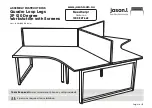
A
pp
en
di
x D
: W
or
ks
he
et
s •
6
5
©2012 Axia Audio
Appendix C:
Channel / IP Worksheets
The scalable nature of Axia Livewire audio networks makes it possible to construct systems of any size - from a
single room to an entire multi-studio facility.
Since Livewire components – Audio Nodes, Elements, StudioEngines, PowerStation, etc. – are connected with
Ethernet, each one requires a unique IP (Internet Protocol) address. IP addresses are four bytes long and are written
in “dotted decimal” form, with each byte represented decimally and separated by a period. For example, in the IP
address 193.32.216.9, the 193 is the value for the first byte, 32 for the second, etc. Since a byte can hold values from
0 to 255, this is the range for each decimal value. If you run a public network, Host IP addresses are assigned to your
organization by your internet service provider and parceled out to individual host computers by your network admin-
istrator. He may give you this number to be entered manually, or could opt for DHCP (Dynamic Host Configuration
Protocol) to let your computer get the address automatically from a pool. Because Livewire devices are permanently
attached and because it is more desirable to know the IP address attached to a particular node (and perhaps assign
them in some kind of logical pattern), we do not support DHCP for our hardware nodes. Therefore, you will need to
enter an IP address into each node.
Livewire systems can support over 10,000 channels of audio; this necessitates giving each audio source or destina-
tion its own unique identifier, called
Channel ID numbers .
As you can imagine, keeping track of so many unique IP addresses and Channel ID numbers is a big job. There-
fore, on the next few pages, we’ve provided you with worksheets that you can use to keep track of the numbers you’ve
assigned.
A logical convention that is often followed will link the Livewire channel number to the last octet of the device IP
address. For example, if a node has an IP address of 192.168.1.12, the channel numbers assigned to the 8 sources of
that node might be 1201 through 1208.
For a more detailed explanation of IP addresses, subnet masks and related issues, we highly suggest that you refer
to “Network Engineering For Audio Engineers”, Chapter 8 of our
Introduction to Livewire: IP Audio System Design
Reference and Primer .
Содержание DESQ
Страница 1: ...RAQ DESQ Installation User s Guide Manual Rev 1 January 2012 p n 1490 00086 001...
Страница 8: ...Introduction viii 2012 Axia Audio...
Страница 10: ...Introduction x 2012 Axia Audio Crimping the spade lugs the smell of soldering flux they ll be missed Not much...
Страница 12: ...Getting Started 2 2012 Axia Audio Open box connect Seven pounds of pure power Who needs big consoles...
Страница 30: ...2 Inputs and Outputs 20 2012 Axia Audio CAT 6 small and light yet sound and data pour forth What magic is this...
Страница 61: ...6 Advanced Controls 51 2012 Axia Audio Mimicking nature streams combine to form anew many become one...
Страница 80: ...Axia Audio a Telos Alliance Company 1241 Superior Ave Cleveland Ohio 44114 USA 1 216 241 7225 www AxiaAudio com...






































